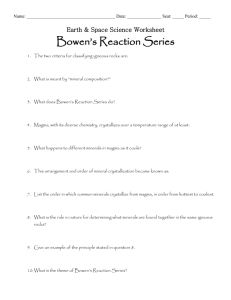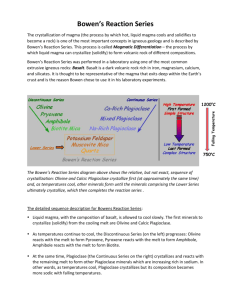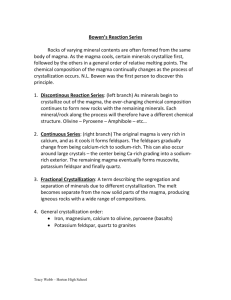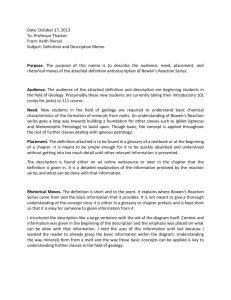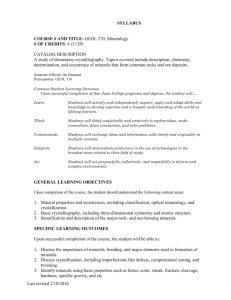Chapter 6- Phase Relations and Binary Systems
advertisement
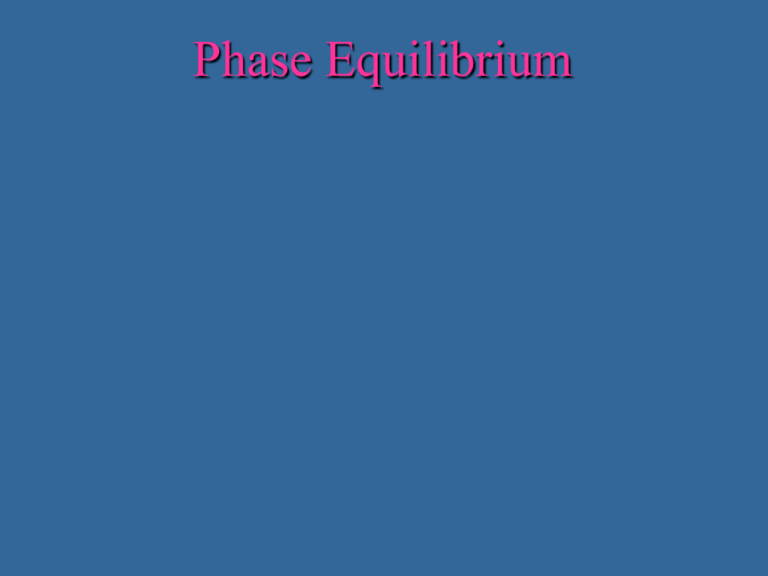
Phase Equilibrium Makaopuhi Lava Lake Magma samples recovered from various depths beneath solid crust From Wright and Okamura, (1977) USGS Prof. Paper, 1004. Makaopuhi Lava Lake Thermocouple attached to sampler to determine temperature From Wright and Okamura, (1977) USGS Prof. Paper, 1004. Makaopuhi Lava Lake Temperature of sample vs. Percent Glass Temperature oc 1250 1200 1150 1100 1050 1000 950 900 0 10 20 30 40 50 60 70 80 90 100 Percent Glass Fig. 6.1. From Wright and Okamura, (1977) USGS Prof. Paper, 1004. Makaopuhi Lava Lake Minerals that form during crystallization Olivine Clinopyroxene Plagioclase Opaque 1250 Liquidus olivine decreases below 1175oC Temperature oC 1200 1150 1100 Melt Crust 1050 1000 Solidus 950 0 10 0 10 20 30 40 50 0 10 20 30 40 50 0 10 Fig. 6.2. From Wright and Okamura, (1977) USGS Prof. Paper, 1004. Makaopuhi Lava Lake Mineral composition during crystallization 100 Olivine Augite Plagioclase Weight % Glass 90 80 70 60 50 .9 .8 .7 Mg / (Mg + Fe) .9 .8 .7 Mg / (Mg + Fe) .6 80 70 An Fig. 6.3. From Wright and Okamura, (1977) USGS Prof. Paper, 1004. 60 Crystallization Behavior of Melts 1. Cooling melts crystallize from a liquid to a solid over a range of temperatures (and pressures) Crystallization Behavior of Melts 1. Cooling melts crystallize from a liquid to a solid over a range of temperatures (and pressures) 2. Several minerals crystallize over this T range, and the number of minerals generally increases as T decreases Crystallization Behavior of Melts 1. Cooling melts crystallize from a liquid to a solid over a range of temperatures (and pressures) 2. Several minerals crystallize over this T range, and the number of minerals increases as T decreases 3. Minerals that form do so sequentially, with considerable overlap Crystallization Behavior of Melts 1. Cooling melts crystallize from a liquid to a solid over a range of temperatures (and pressures) 2. Several minerals crystallize over this T range, and the number of minerals increases as T decreases 3. Minerals that form do so sequentially, with considerable overlap 4. Minerals that involve solid solution change composition as cooling progresses Crystallization Behavior of Melts 1. Cooling melts crystallize from a liquid to a solid over a range of temperatures (and pressures) 2. Several minerals crystallize over this T range, and the number of minerals increases as T decreases 3. The minerals that form do so sequentially, with consideral overlap 4. Minerals that involve solid solution change composition as cooling progresses 5. The melt composition also changes during crystallization Crystallization Behavior of Melts 1. Cooling melts crystallize from a liquid to a solid over a range of temperatures (and pressures) 2. Several minerals crystallize over this T range, and the number of minerals increases as T decreases 3. The minerals that form do so sequentially, with consideral overlap 4. Minerals that involve solid solution change composition as cooling progresses 5. The melt composition also changes during crystallization 6. The minerals that crystallize (as well as the sequence) depend on T and X of the melt Crystallization Behavior of Melts 1. Cooling melts crystallize from a liquid to a solid over a range of temperatures (and pressures) 2. Several minerals crystallize over this T range, and the number of minerals increases as T decreases 3. The minerals that form do so sequentially, with consideral overlap 4. Minerals that involve solid solution change composition as cooling progresses 5. The melt composition also changes during crystallization 6. The minerals that crystallize (as well as the sequence) depend on T and X of the melt 7. Pressure can affect the types of minerals that form and the sequence Crystallization Behavior of Melts 1. Cooling melts crystallize from a liquid to a solid over a range of temperatures (and pressures) 2. Several minerals crystallize over this T range, and the number of minerals increases as T decreases 3. The minerals that form do so sequentially, with consideral overlap 4. Minerals that involve solid solution change composition as cooling progresses 5. The melt composition also changes during crystallization 6. The minerals that crystallize (as well as the sequence) depend on T and X of the melt 7. Pressure can affect the types of minerals that form and the sequence 8. The nature and pressure of the volatiles can also affect the minerals and their sequence The Phase Rule F=C-f+2 F = # degrees of freedom The number of intensive parameters that must be specified in order to completely determine the system The Phase Rule F=C-f+2 F = # degrees of freedom The number of intensive parameters that must be specified in order to completely determine the system f = # of phases phases are mechanically separable constituents The Phase Rule F=C-f+2 F = # degrees of freedom The number of intensive parameters that must be specified in order to completely determine the system f = # of phases phases are mechanically separable constituents C = minimum # of components (chemical constituents that must be specified in order to define all phases) The Phase Rule F=C-f+2 F = # degrees of freedom The number of intensive parameters that must be specified in order to completely determine the system f = # of phases phases are mechanically separable constituents C = minimum # of components (chemical constituents that must be specified in order to define all phases) 2 = 2 intensive parameters Usually = temperature and pressure for us geologists High Pressure Experimental Furnace Cross section: sample in red the sample! 800 Ton Ram Carbide Pressure Vessle SAMPLE Graphite Furnace 1 cm Furnace Assembly Fig. 6.5. After Boyd and England (1960), J. Geophys. Res., 65, 741-748. AGU 1 - C Systems 1. The system SiO2 Fig. 6.6. After Swamy and Saxena (1994), J. Geophys. Res., 99, 11,787-11,794. AGU 1 - C Systems 2. The system H2O Fig. 6.7. After Bridgman (1911) Proc. Amer. Acad. Arts and Sci., 5, 441-513; (1936) J. Chem. Phys., 3, 597-605; (1937) J. Chem. Phys., 5, 964966. 2 - C Systems A. Systems with Complete Solid Solution 1. Plagioclase (Ab-An, NaAlSi3O8 - CaAl2Si2O8) Fig. 6.8. Isobaric T-X phase diagram at atmospheric pressure. After Bowen (1913) Amer. J. Sci., 35, 577-599. Bulk composition a = An60 = 60 g An + 40 g Ab XAn = 60/(60+40) = 0.60 F=2 1. Must specify 2 independent intensive variables in order to completely determine the system = a divariant situation same as: 2. Can vary 2 intensive variables independently without changing f, the number of phases Get new phase joining liquid: liq Must specify oT and plag or can vary these without X X An An Now cool to 1475 C (point b) ... what happens? first crystals of plagioclase: = 0.87 (point c) changing the number of phases F=? F = 2 - 2 + 1 = 1 (“univariant”) Must specify only one variable from among: plag liq plag T X liq X (P constant) X X An An Ab Ab Considering an isobarically cooling magma, X liq An plag and X An are dependent upon T The slope of the solidus and liquidus are the expressions of this relationship At 1450oC, liquid d and plagioclase f coexist at equilibrium A continuous reaction of the type: liquidB + solidC = liquidD + solidF The lever principle: Amount of liquid Amount of solid ef = de where d = the liquid composition, f = the solid composition and e = the bulk composition d f e D liquidus de ef solidus When Xplag h, then Xplag = Xbulk and, according to the lever principle, the amount of liquid 0 Thus g is the composition of the last liquid to crystallize at 1340oC for bulk X = 0.60 Final plagioclase to form is i Now f = 1 so F = 2 - 1 + 1 = 2 plag when X An = 0.60 Note the following: 1. The melt crystallized over a T range of 135oC * 4. The composition of the liquid changed from b to g 5. The composition of the solid changed from c to h Numbers refer to the “behavior of melts” observations * The actual temperatures and the range depend on the bulk composition Equilibrium melting is exactly the opposite o Heat An and the first melt is g at An and 1340 C 60 20 Continue heating: both melt and plagioclase change X Last plagioclase to melt is c (An87) at 1475oC Fractional crystallization: Remove crystals as they form so they can’t undergo a continuous reaction with the melt At any T Xbulk = Xliq due to the removal of the crystals Partial Melting: Remove first melt as forms Melt Xbulk = 0.60 first liquid = g remove and cool bulk = g final plagioclase = i Note the difference between the two types of fields The blue fields are one phase fields Any point in these fields represents a true phase composition Liquid Plagioclase The blank field is a two phase field plus Liquid Any point in this field represents a bulk composition composed of two phases at the edge of the blue fields and connected by a horizontal tie-line Plagioclase 2. The Olivine System Fo - Fa (Mg2SiO4 - Fe2SiO4) also a solid-solution series Fig. 6.10. Isobaric T-X phase diagram at atmospheric pressure After Bowen and Shairer (1932), Amer. J. Sci. 5th Ser., 24, 177-213. 2-C Eutectic Systems Example: Diopside - Anorthite No solid solution Fig. 6.11. Isobaric T-X phase diagram at atmospheric pressure. After Bowen (1915), Amer. J. Sci. 40, 161-185. Cool composition a: bulk composition = An70 Cool to 1455oC (point b) Continue cooling as Xliq varies along the liquidus Continuous reaction: liqA anorthite + liqB at 1274oC f = 3 so F = 2 - 3 + 1 = 0 invariant (P) T and the composition of all phases is fixed o Must remain at 1274 C as a discontinuous reaction proceeds until a phase is lost Discontinuous Reaction: all at a single T Use geometry to determine Left of the eutectic get a similar situation #s are listed points in text Note the following: 1. The melt crystallizes over a T range up to ~280oC 2. A sequence of minerals forms over this interval - And the number of minerals increases as T drops 6. The minerals that crystallize depend upon T - The sequence changes with the bulk composition Augite forms before plagioclase Gabbro of the Stillwater Complex, Montana This forms on the left side of the eutectic Plagioclase forms before augite Ophitic texture Diabase dike This forms on the right side of the eutectic Also note: • The last melt to crystallize in any binary eutectic mixture is the eutectic composition • Equilibrium melting is the opposite of equilibrium crystallization • Thus the first melt of any mixture of Di and An must be the eutectic composition as well Fractional crystallization: Fig. 6.11. Isobaric T-X phase diagram at atmospheric pressure. After Bowen (1915), Amer. J. Sci. 40, 161-185. Partial Melting: C. Binary Peritectic Systems Three phases enstatite = forsterite + SiO2 Figure 6.12. Isobaric T-X phase diagram of the system Fo-Silica at 0.1 MPa. After Bowen and Anderson (1914) and Grieg (1927). Amer. J. Sci. C. Binary Peritectic Systems Figure 6.12. Isobaric T-X phase diagram of the system Fo-Silica at 0.1 MPa. After Bowen and Anderson (1914) and Grieg (1927). Amer. J. Sci. Figure 6.12. Isobaric T-X phase diagram of the system Fo-Silica at 0.1 MPa. After Bowen and Anderson (1914) and Grieg (1927). Amer. J. Sci. i = “peritectic” point 1557oC have colinear Fo-En-liq geometry indicates a reaction: Fo + liq = En consumes olivine (and liquid) resorbed textures When is the reaction finished? 1557 im k d Fo En Bulk X c x i m k y 1557 1543 d c bulk X Fo En Cr Incongruent Melting of Enstatite of En does not melt of same composition Rather En Fo + Liq i at the peritectic Melt Partial Melting of Fo + En (harzburgite) mantle + Fo also first liq = i Remove i and cool Result = ? En i 1557 Fo d En 1543 c Cr Immiscible Cool X = n o At 1960 C hit solvus exsolution 2 liquids o and p f=2 F=1 both liquids follow solvus o At 1695 C get Crst also Reaction? 1695 Mafic-rich liquid Crst Silica-rich liquid Liquids Pressure Effects Different phases have different compressibilities Thus P will change Gibbs Free Energy differentially Raises melting point Shift eutectic position (and thus X of first melt, etc.) Figure 6.15. The system FoSiO2 at atmospheric pressure and 1.2 GPa. After Bowen and Schairer (1935), Am. J. Sci., Chen and Presnall (1975) Am. Min. D. Solid Solution with Eutectic: Ab-Or (the alkali feldspars) Eutectic liquidus minimum Figure 6.16. T-X phase diagram of the system albiteorthoclase at 0.2 GPa H2O pressure. After Bowen and Tuttle (1950). J. Geology. Effect of PH O on Ab-Or 2 Figure 6.17. The Albite-K-feldspar system at various H2O pressures. (a) and (b) after Bowen and Tuttle (1950), J. Geol, (c) after Morse (1970) J. Petrol.
